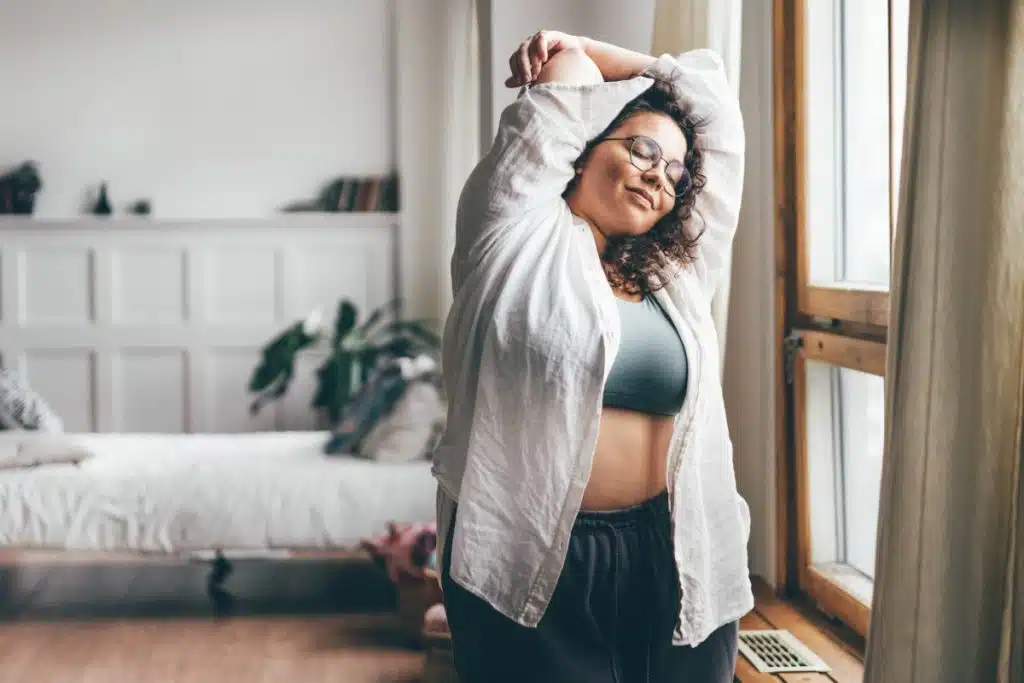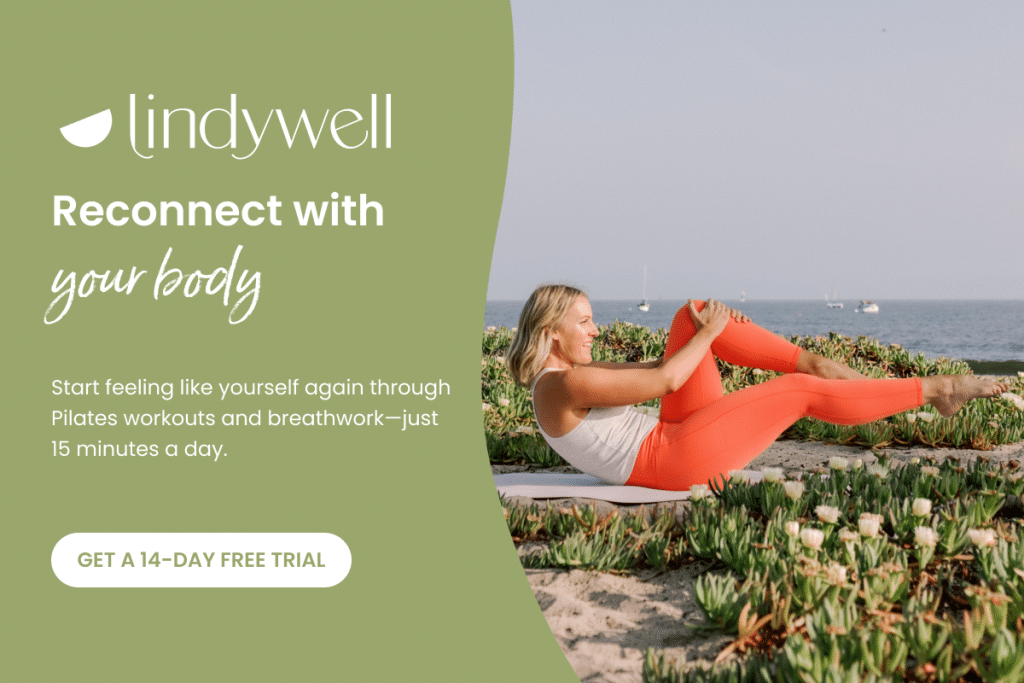
What is body positivity? Well, that’s a great question—and one that many are wondering as the movement has morphed and been co-opted in different ways. To me, body positivity is about showing love and appreciation for your body.
More importantly, it’s about choosing that love for your body over the messages from our modern culture that your body is a representation of your worth—that you need to change it to fit a cultural expectation of what defines a “good” “beautiful” or “healthy” body.
I also think, however, that the movement has led some people to think that embracing the body you have today means that you don’t need to care for it. Or that you can’t work toward fitness or health goals and also love your body now.
Ultimately, most of us in the wellness space will answer the question of “what is body positivity” differently. Here at Lindywell, we take a grace over guilt approach while also supporting our bodies for long-term health.
If that’s the way you approach life (or want to!), then let’s talk about what body positivity really means and how it can fit into a wholistically healthy life.

The Origins of the Body Positivity Movement
Body positivity can trace its origins to a 20th-century social movement started by intersectional Black and LGBTQIA+ activists. Their goal was to resist the discrimination and marginalization of bodies that exist outside Western society’s “thin, white, straight, cis” norm.
The first wave of body positivity celebrated all sizes, races, abilities, genders, and sexualities. It centered on their unique experiences and encouraged everyone to cultivate healthy relationships with their bodies.
In short, this movement is rooted in confronting unrealistic beauty ideals to embrace body acceptance and representation for everyone. And I love that!
How Modern Body Positivity Is Missing the Mark
There are many ways the modern body positivity movement is missing the mark. As it’s been picked up on social media, the sentiment has been co-opted, leading to misrepresentation, unnecessary pressure, and more. Here’s what the research tells us about how body positivity is actually hurting more than helping.
It’s Leaving People Out
Let’s jump ahead more than half a century to the modern iteration of body positivity. In a recent analysis of #BodyPositive TikTok videos, 93 percent featured conventionally thin bodies, while only 32 percent featured larger bodies. What’s more, less than 35 percent even mentioned the theme of body image acceptance at all.
In another study, researchers looked at 500 Instagram posts with the hashtags #BodyPositivity or #BodyPositive to examine the diversity within this content. Less than one-fifth of the posts showed a non-white person, about one-sixth showed someone in a larger body, three showed a queer person, and two showed someone with a disability. Most of the content overwhelmingly focused on the pursuit of fitness and weight loss.
Keep in mind that this began as a countercultural movement to push back against narrow, exclusive beauty norms and create space for all bodies to thrive. But social media’s interpretation of “body positivity” can erase the experiences of those for whom this term originated.
The consequences speak for themselves. According to a survey of 11,620 adults across the U.S., those from marginalized communities are more likely to face appearance-related stigma. Folks in larger bodies are especially vulnerable to prejudice, harassment, or discrimination for their weight, which can influence eating disorder behaviors.
If Often Feels Unattainable
Another potential issue with body positivity is that it’s often an unattainable goal to strive for. As healing as radical self-acceptance and affirmation can be, we cannot always will ourselves to just manufacture these feelings.
More than 60 percent of 35 to 54-year-olds across the globe confirm that poor body image has had an adverse effect on their well-being. Whether your dissatisfaction is a result of size, weight, shape, or some other external factor, you might not be able to reframe this internalized critique at a moment’s notice.
Sometimes it’s hard to love how we look in the mirror—and no amount of positive thinking will transform this mindset entirely. This is where body positivity can fall short.
It Feels Pressuring
Messages such as, “Be comfortable in your own skin,” or “Love yourself no matter what,” sound beneficial on the surface. These sentiments, however well-intentioned, can actually make us feel worse. Research shows that when a body positivity mantra comes across as controlling or pressuring, it can undermine our sense of agency and harm our self-esteem.
Consider Opting for Body Neutrality Instead
Body neutrality removes the pressure of feeling like you need to love all facets of your external appearance at all times. Rather, it encourages you to recognize that your body is worthy of love, respect, and kindness no matter how it looks.
Psychologists Dr. Mia Pellizzer and Dr. Tracy Wade have established three main components to define “body neutrality” as:
- A mindful, realistic, and flexible view of the body as a whole
- A willingness to respect, care for, and appreciate how the body functions
- A realization that self-worth is not based on external appearance
The objective of body neutrality is not to ignore complicated emotions that come to the surface when you look in a mirror, wear a certain outfit, or see a post on social media. It’s to recognize none of that defines you.
This neutral outlook on body image lets self-compassion and curiosity replace criticism, so you’re free to accept the truth: Nobody is perfect, and that’s alright. You have more important qualities to offer than how you look.
How to Be Body Positive or Neutral—and Also Focus on Long-Term Health
I believe that we can be body-positive and still work toward long-term health goals. I don’t just believe this—I know it to be key to feeling good in every season of life. This comes down to how you approach health and fitness. It’s not about forcefulness or physical appearance but listening to your body and setting yourself up for health and happiness in every season of life.
If you want to be body-positive (or neutral), while still taking care of your body, here are a few helpful strategies.
Let your body lead.
If you’re working out just to check a box or forcing yourself through workouts that you don’t like, it’s time to take a step back. Let your body lead. Is it craving a slow, stretching workout? Or is it feeling ready for the challenge of a HIIT or strength-training workout? This is about focusing on movement that feels good for your body.
Focus on consistency, not duration.
Creating long-term health is not about working out for 60+ minutes every time you move your body. It’s about prioritizing that movement daily, even if it’s only for 10-15 minutes. This comes back to giving your body what it needs rather than forcing some arbitrary version of what a workout “should be.” Plus, we all have 10-15 minutes each day for movement, no matter how busy we are!
Set an intention.
Workouts shouldn’t be focused on how your body looks. Instead, I want you to focus each workout on an intention that has nothing to do with what you see in the mirror. For example, your intention may be to stoke some creativity for your workday or get an energy boost mid-day. Movement fuels your mental health, gives you energy, reduces stress and so much more. Being body positive is all about shifting the focus to how you feel, rather than how you look.
Incorporate more nourishing foods.
Eating “healthy” doesn’t mean you need to have a salad every day. It means choosing foods that nourish your body (provide fuel and energy) and your mind (tastes good). I want you to think about both your mind and body when thinking about long-term health goals. If one is thriving and the other isn’t, you’ll struggle to create a balanced and fulfilling life.
If you want support on moving your body consistently, choosing nourishing foods, and focusing on grace over guilt in your health journey, start your 14-day free trial of Lindywell. Join thousands of women across the globe who have finally found the one workout program that keeps them consistent while reducing stress and building strength!
Embrace Your Health Journey With Body Positivity
Body positivity matters—but the message has been skewed. In its purest form, this movement includes, represents, embraces, and celebrates the full spectrum of human bodies. It was never meant to erase or overlook anyone, nor was it created to shame you into a disingenuous, performative brand of self-love.
If you want to cultivate a healthier, more authentic relationship with yourself, I invite you to join Lindywell. As a member, you get immediate access to 350+ Pilates classes, conscious breathwork sessions, and nourishing recipes. You will also be part of a diverse community that champions the vibrance and uniqueness we all bring to this world.






